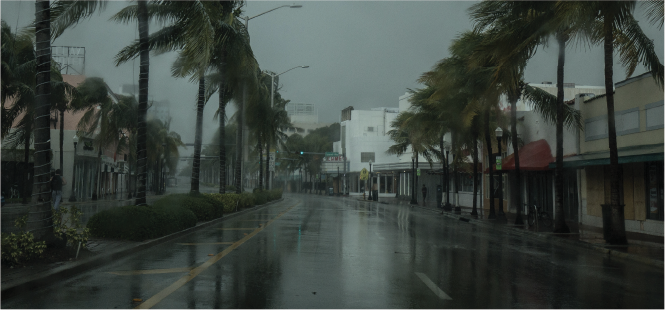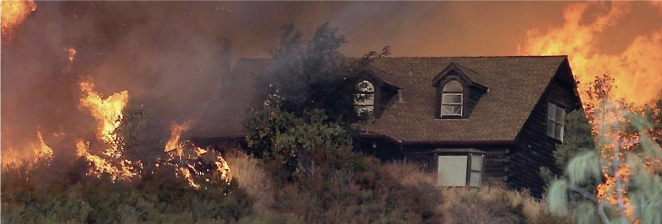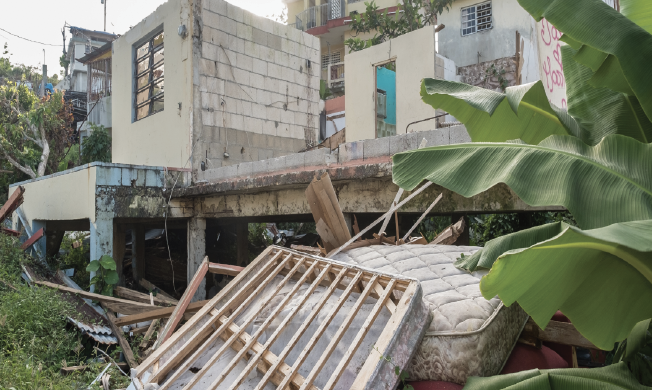From the hurricanes that hit Texas, Florida and Puerto Rico, to the wildfires that consumed parts of California’s Wine Country, this year has been fraught with catastrophic natural disasters which have uprooted countless Americans from their stable lives. These disasters, also including tornadoes, hail storms, droughts, cyclones and floods, destroyed properties, businesses, communities, cities and United States territories; left families and their pets without shelter, food, utilities and vulnerable to disease; and caused hundreds of deaths and casualties.
The National Oceanic and Atmospheric Administration (NOAA) reports that 15 weather and climate disasters in the U.S. have each caused over $1 billion in damages in 2017 alone. These events have resulted in the death of 282 people and have had consequential economic effects in the locations affected. As of October, the costs for the major hurricanes—Hurricanes Harvey, Irma and Maria—are still being calculated. An article from USA Today, however, estimates that Hurricane Harvey will reach at least $190 billion in damages.
Hurricanes
Hurricane Harvey made landfall in August near Rockport, Texas, and its damaging effects spread across Houston and other surrounding areas. Harvey caused torrential rainfall and flooding, causing more than 30 inches of rainfall on almost 7 million people and over 50 inches on 11,000 people. This historical flooding, according to the NOAA, separated over 30,000 individuals from their homes and damaged or destroyed over 200,000 homes and businesses. Eighty-four lives were tragically lost because of the effects of Harvey.
 In the following month, Hurricane Irma stormed through U.S. Virgin Islands St. John and St. Thomas before making landfall at Cudjoe Key, Florida. The citizens of Florida Keys witnessed 25 percent of buildings destroyed while 65 percent were significantly damaged. The coasts of Florida and South Carolina, Jacksonville, FL and Charleston, SC were also affected by severe winds and coastal flooding caused by storm surge. Over the course of six days, Hurricane Irma cost the lives of 95 people.
In the following month, Hurricane Irma stormed through U.S. Virgin Islands St. John and St. Thomas before making landfall at Cudjoe Key, Florida. The citizens of Florida Keys witnessed 25 percent of buildings destroyed while 65 percent were significantly damaged. The coasts of Florida and South Carolina, Jacksonville, FL and Charleston, SC were also affected by severe winds and coastal flooding caused by storm surge. Over the course of six days, Hurricane Irma cost the lives of 95 people.
Almost two weeks after Hurricane Irma, Puerto Rico and the U.S. Virgin Island of St. Croix were hit by Hurricane Maria. The winds of Hurricane Maria caused detrimental damage to Puerto Rico’s transportation, agricultural, communication and energy infrastructure, left nearly all of the territory without electricity, and caused the deaths of 38 people. Moreover, the extreme rainfall—reaching up to 37 inches—covered the island in flooding and mudslides. It will take time for Puerto Rico to recover their commerce and standard of living as its infrastructure is rebuilt.
Wildfires
The intense wildfires in the western and northwestern United States, most likely affected by the extreme drought that took place in several states, began in the beginning of June and continued intermittently until the end of September. Numerous fires burned over 8.4 million acres of land and consumed hundreds of homes. This year exceeded the 10-year annual average of 5.9 million acres destroyed by wildfires.
In the Summer of 2017, dry weather conditions and drought created multiple fires in Montana, which burned over 1 million acres throughout the state. According to the U.S. Department of Agriculture, the largest fire was the Lodgepole Complex fire, impacting over 270,000 acres. Ranchers and farmers who were affected by recent natural disasters, by loss of livestock, grazing land, fences and trees, can receive help from safety-net programs administered by the Farm Service Agency (FSA) to recover their losses.
 The Eagle Creek fire in the Columbia River Gorge, one of many wildfires in Oregon, began in early September. Believed to be sparked by illegal fireworks, the fires spread over 48,831 acres by October. Cascade Locks and Troutdale areas were given evacuation notices to leave their homes, while Portland experienced poor air quality from fallen ash. Firefighters were helped by cool weather and high humidity in containing the fire. In total, the wildfires that took place burned an area the size of Rhode Island and required over $340 million in firefighting costs, torching Oregon’s beloved nature landmarks, including Mount Jefferson and the Three Sisters.
The Eagle Creek fire in the Columbia River Gorge, one of many wildfires in Oregon, began in early September. Believed to be sparked by illegal fireworks, the fires spread over 48,831 acres by October. Cascade Locks and Troutdale areas were given evacuation notices to leave their homes, while Portland experienced poor air quality from fallen ash. Firefighters were helped by cool weather and high humidity in containing the fire. In total, the wildfires that took place burned an area the size of Rhode Island and required over $340 million in firefighting costs, torching Oregon’s beloved nature landmarks, including Mount Jefferson and the Three Sisters.
In the second week of October, the “deadliest week in California wildfire history” report state officials, many large wildfires devastated parts of northern California, including Napa, Lake, Sonoma, Mendocino, and Butte counties. According to the NOAA, the previous wet winter season, the dried vegetation from seasonal dryness during summer and autumn, and the hot, windy weather in October contributed to wildfire fuels. The wildfires became out of control very quickly, destroying thousands of homes and businesses and causing at least 40 fatalities.
Less than two months after the fires in northern California, the Santa Barbara and Ventura counties west of Los Angeles were hit by the Thomas Fire, which is currently the second largest wildfire in the state’s history. In early December, powerful Santa Ana winds, going as fast as 60 mph, ignited flames through dry chaparral and blew embers forcefully through 100-foot buffers protecting nearby homes.
At time of writing, the fire has burned through 270,000 acres, an area larger than New York City, Washington D.C., and San Francisco combined, and 40 percent of the fire is still not contained. It is close to surpassing California’s largest recorded fire—2003 Cedar Fire near San Diego—which consumed 273,246 acres of land. So far, the Thomas Fire has burned more than 1,000 buildings; caused more than 100,000 people to flee from their homes; created over $124 million in damages; and resulted in multiple casualties, including 2 deaths.
More than 8,000 brave firefighters are risking their lives to contain the fire and protect the homes of nearby communities during the holiday season.
Tornadoes and Floods
In addition to hurricanes and wildfires, other natural disasters such as tornadoes and storms caused significant destruction and fatalities in the nation, costing at least $1 billion in damages.
 Tornadoes alone, a little over 1300 in number, took the lives of 34 Americans between the months January and May. In the South, USA Today reports, 79 tornadoes tore through Gulf states and South Carolina in January, costing $1.1 billion and resulting in 24 deaths. Between February and March, 70 tornadoes swept across central and southern states, culminating in $1.8 billion worth of damage and causing 6 deaths. Eleven states in the Midwest were hit by tornadoes that created widespread destruction and an estimate cost of $2.1 billion.
Tornadoes alone, a little over 1300 in number, took the lives of 34 Americans between the months January and May. In the South, USA Today reports, 79 tornadoes tore through Gulf states and South Carolina in January, costing $1.1 billion and resulting in 24 deaths. Between February and March, 70 tornadoes swept across central and southern states, culminating in $1.8 billion worth of damage and causing 6 deaths. Eleven states in the Midwest were hit by tornadoes that created widespread destruction and an estimate cost of $2.1 billion.
California, Missouri and Arkansas dealt with extreme flooding in the months of February, April and May, respectively. Heavy rainfall in northern and central California caused damage by floods, landslides and erosion. USA Today reports that about 188,000 residents had to be evacuated once the Oroville Dam spillway was damaged. Rivers along Missouri, Arkansas, Illinois and other states were flooded after 15 inches of rainfall breached levees. Taken together, these floods cost over $3 billion in damages and caused 25 fatalities.
Do You Think SBA
Is Only About Small Business Loans?
You’re Wrong.
Countless Americans that have been affected by these listed natural disasters, are now left to rebuild their lives after this devastating loss. Some have to rebuild their homes, replace their possessions and recover their businesses. This will be incredibly costly if these individuals do not have insurance. According to the Federal Emergency Management Agency (FEMA), 75 percent of small businesses do not have a disaster plan, and 40 percent of small businesses displaced by a natural disaster do not reopen because of exorbitant costs. Even if they do have insurance, it will cover much but not all of the required costs.
Astonishingly, every 2 out of three homes in the United States are underinsured by 22 percent, reports Value Penguin. Among renters, 3 out of five are not insured for their belongings. Of those homes that experienced flood damage from Hurricane Harvey, only 20 percent had flood insurance. These natural disaster victims with or without insurance, however, will find a resource in the Small Business Association (SBA), who offer low-interest Disaster Loans for businesses, private nonprofits, homeowners and renters who need assistance with uninsured costs.
Even those insured for natural disaster damage are encouraged to apply for a SBA Disaster Loan to provide funding until their check arrives from their insurance company. The SBA can lend you the amount of your total loss, even if you are unsure about how much your insurance will cover. The money received from your insurance, in turn, must be used to pay down your loan.
During Fiscal Year 2017, the SBA approved a total of 27,263 disaster loans for a total of $1.7 billion— $1.3 billion for home disaster loans and $296 million for business disaster loans. The SBA processed 84,705 home loan applications and 10,882 business disaster loan applications, making a total of 95,587 processed loan applications. For the victims of the California wildfires, the SBA’s Disaster Field Operations Center-West approved more than $30 million in 218 federal disaster loans for California businesses and residents.
“SBA’s disaster assistance employees are committed to helping businesses and residents rebuild as quickly as possible,” said Director Tanya N. Garfield in a press release. “Don’t miss out on any assistance you may be entitled to by not registering. You don’t need to wait for your insurance to settle or obtain a contractor’s estimate.”
SBA offers one-on-one assistance for disaster loan applicants at multiple local recovery centers. Applicants do not have to make an appointment to have someone walk them through the loan application process.
 In 2018, the SBA is continuing to aid victims of these natural disasters through loans. For instance, it approved over $1 billion in low-interest disaster loans for over 28,000 Puerto Rico residents and businesses to help them recover from Hurricanes Irma and Maria. The deadline for filing for physical property damage is March 20, 2018. For economic injury loan applications, the deadline is June 11, 2018 for Hurricane Irma, and June 20, 2018 for Hurricane Maria.
In 2018, the SBA is continuing to aid victims of these natural disasters through loans. For instance, it approved over $1 billion in low-interest disaster loans for over 28,000 Puerto Rico residents and businesses to help them recover from Hurricanes Irma and Maria. The deadline for filing for physical property damage is March 20, 2018. For economic injury loan applications, the deadline is June 11, 2018 for Hurricane Irma, and June 20, 2018 for Hurricane Maria.
The University of Houston has received a $2.3 million continuation grant from the SBA to help them create 300 new small businesses in Houston, Texas. The recipients of the award—Bauer College’s Small Business Development Center—services around 10,000 businesses a year in 32 counties along the Gulf Coast.
Other Resources
Wherever you are in the United States, whether you are a resident, homeowner, business owner or all of the above, when disaster hits, there are resources to help you. Immediately after a disaster, contact the Federal Emergency management Agency (FEMA), Red Cross, and the Disaster Assistance Improvement Program (DAIP) for urgent needs like aid and shelter, various support services, and up-to-date information.
If you are a small business owner, there are additional resources available to you during the recovery process:
- If you have a loan from the SBA, you may be eligible for deferred loan payments. If your loan postdates August 25, 2017 and you are located in a federal disaster area, your principal and interest payments will be deferred for 12 months. If your business is located near a disaster area, you may be eligible for a 9-month payment deferral.
- Small business owners can apply for federal assistance—in the form of cash grants— through the Federal Emergency Management Agency (FEMA), online or by calling 1-800-621-FEMA.
- Local Small Business Development Centers (SBDCs) are available to help small businesses complete forms for disaster relief, recover records and relaunch their businesses.
- Small business owners should call their insurance agents to settle their claims after a natural disaster. For detailed information on how to do this, visit the Insurance Information Institute’s website.
- Check to see if your industry and/or vendors offer help for your type of business in cases of emergency.
The executive women of NAWRB’s Diversity and Inclusion Council (NDILC), dedicated to helping raise the number of C-suite women and grow women’s employment at all levels in the housing ecosystem, are providing support for hurricane victims, including those businesses indirectly affected by these natural disasters.
NDILC council member Tami Bonnell is CEO of Exit Realty Corp. International, which has donated $300,000 each to victims of Hurricane Harvey and Hurricane Irma. “This record-breaking storm has left many families devastated,” stated Steve Morris, Exit Realty Corp. Founder and Chairman. “At times like this our EXIT Family rallies to help. It’s what we do.” The organization pooled these funds for those hit hardest by these natural disasters from their Habitat for Humanity and Red Cross disaster relief efforts.

Linda Erkkila, NDILC council member, is General Counsel and Executive Vice President of Human Resources for Safeguard, a mortgage field services industry leader. Safeguard has provided outreach for hurricanes Harvey, Irma, Maria and Nate, as well as for the California wildfires by inspecting property damage for their vendor base. In addition, the organization sent their field quality control (FQC) to help heavily-impacted areas in Puerto Rico and supplied the island with satellite Wi-Fi to facilitate communication.
NAWRB is dedicated to help those affected by these recent natural disasters find resources that can help them rebuild their homes, restart their businesses and regain a sense of stability in their lives.
“The hurt of losing a business you’ve worked decades to create, or a home that you purchased for your family through years of work and sacrifice, cannot be put into words,” said Desirée Patno, NAWRB CEO and President. “Single mothers lost their homes, a place of sanctuary and stability for themselves and their children, entrepreneurs running businesses out of their primary residences suffered a dual loss, and family-owned businesses have been forced to replace all equipment. These individuals, and many others with unique circumstances, now have to pick up the pieces and start anew, but they do not have to do so alone.”

 Login
Login
